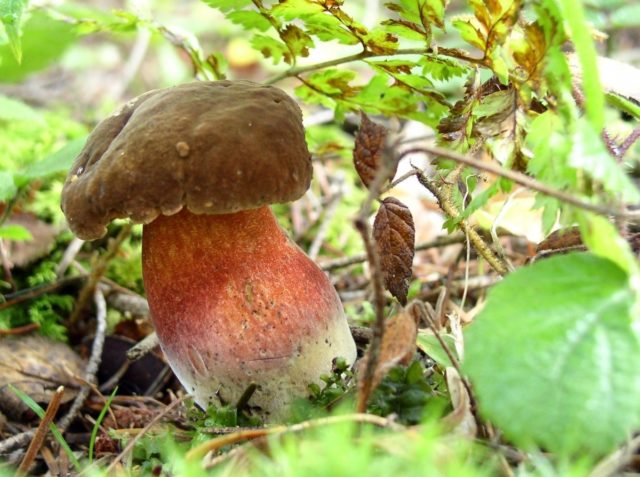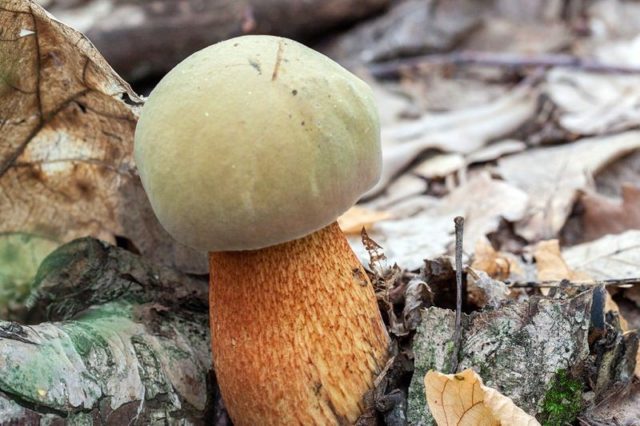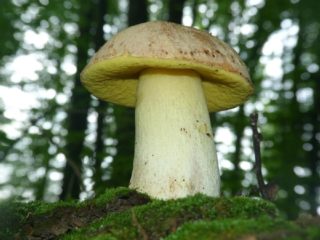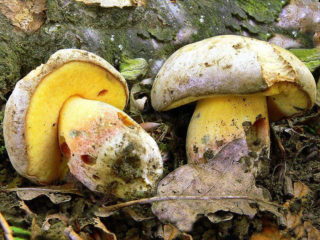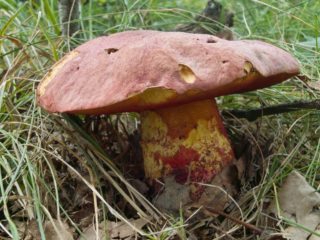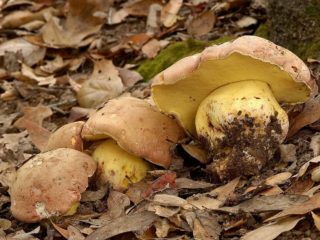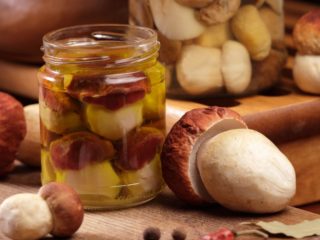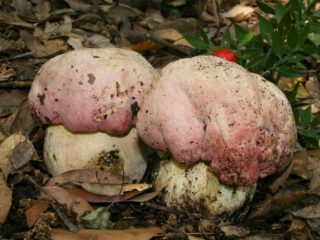Content
Purple boletus is a tubular mushroom belonging to the Boletovye family, the Borovik genus. Another name is purple boletus.
What the purple pains look like
The cap of a young purple painter has a spherical shape, then becomes convex. Its diameter is from 5 to 20 cm. The edges of the cap are wavy, the surface is dry, velvety, bumpy, slightly slimy in wet weather. The color is uneven: the background is greenish-gray or grayish, with reddish, reddish-brown, pink or wine zones on it. When pressed, dark blue spots appear. The hat is often eaten by pests.
Bolette purple looks very impressive
The tubular layer in young specimens is lemon-yellow, with time it becomes yellowish-greenish. The pores are small orange-red or blood-red, turn blue when pressed. The spores are 10.5-13.5x4-5.5 microns in size. The powder is greenish or olive brown.
A young leg is tuberous, then becomes cylindrical. Its height is 6-15 cm, thickness is 2-7 cm. The surface is lemon-yellow with a reddish, rather dense mesh, when pressed it turns black and blue.
The flesh of a purple sore is firm, lemon-yellow, at first it turns black at the break, then it acquires a wine-red hue. The smell is not pronounced, sourish, with fruity notes, the taste is sweetish.
Boletus purple can be confused with other related species.
Similar species
Speckled oak... Conditionally edible species. The cap is pillow-shaped or hemispherical. Its diameter is from 5 to 20 cm. The skin is dry, velvety, matte, sometimes mucous. The color is varied: brown, brown, reddish, chestnut, with a greenish tint. The leg is thick, fleshy, sometimes thickened at the bottom, tuberous or barrel-shaped. The surface is orange with reddish scales. The pulp is yellow, red-brown at the stem. The main difference from Painted Purple is that it turns blue at a rift.
Speckled oak tree grows in the middle zone of the Russian Federation, in the Caucasus and Siberia, often settles on mosses
Satanic mushroom... It is called false white because of its physical resemblance. Inedible. The hat is large and thick, up to 20 cm in diameter. At first it is hemispherical, then it looks like a pillow. The color is white with a yellowish, grayish or pinkish tint. The surface in young specimens is velvety and dry, in mature specimens it is bare, smooth. The leg is first in the form of a ball, then stretches out and becomes like a tuber, expanded at the bottom. The mature height is 15 cm, the thickness is 10 cm. The surface is reticulate, the color is uneven: yellowish-reddish at the top, red in the middle, yellowish or brown at the bottom. The pulp is white, at the bottom with a red tint, turns blue at the break. Young specimens have a faint pungent aroma, old ones smell like rot. It grows in areas with a warm climate. In Russia, it is distributed in the south of the European part, in the Caucasus and in Primorye.
The main difference from the purple pain is the more intensely colored leg.
Olive brown oak tree... Conditionally edible.Outwardly, it is almost the same as purple hurts, and can only be distinguished by the absence of a fruity smell.
Boletus olive-brown can be distinguished from purple only by its smell
Where do purple boletus grow
The fungus is thermophilic, rather rare. Distributed in Europe, in areas with a warm climate. In Russia, purple sore is found in the Krasnodar Territory, Rostov and Astrakhan Regions. Prefers to settle in deciduous and mixed forests next to oak and beech. Grows in hilly and mountainous areas, loves calcareous soils. It grows in single specimens or in small groups of 2-3. Fruiting from June to September.
Is it possible to eat purple boletus
Boletus purple belongs to inedible and poisonous, it cannot be eaten. Little information is available on toxicity. Eating food does not lead to severe poisoning.
Poisoning symptoms
Common symptoms include severe abdominal pain, nausea, and vomiting. Other signs will depend on the type of toxic substance. In any case, there are disturbances in the work of the digestive system. Fast-acting toxins are less dangerous to humans than slow-acting poisons.
Poisoning with sore purple is accompanied by nausea and pain in the stomach.
First aid for poisoning
You cannot self-medicate. At the first suspicion, you need to immediately call an ambulance. Before that, do the following:
- Flush the stomach to get rid of the toxic substance. To do this, you need to drink about 1 liter of liquid and induce vomiting. Repeat the procedure to clean water. It is recommended to use boiled water with soda diluted in it (for 1 liter - 1 tsp).
- Cleanse the intestines. Take a laxative or an enema.
- Take a sorbent. Activated carbon is traditionally used.
- Drink plenty of fluids. Weak tea, mineral water will do.
Conclusion
Boletus purple is a rather rare poisonous mushroom. It has many similarities with other boletus mushrooms, including edible ones.

